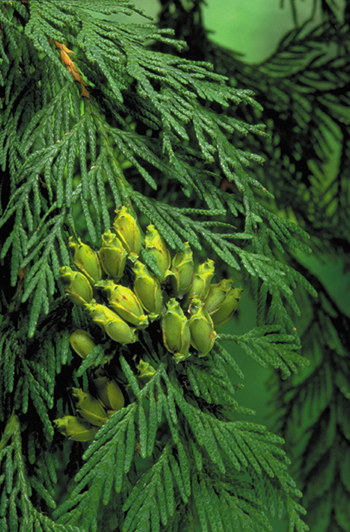British Columbia's provincial symbols
Located on the west coast of Canada, British Columbia became the sixth province of Canada when it joined Confederation in 1871.
Origin of the name
The southern part of the area now known as British Columbia was called “Columbia”, after the Columbia River. The central region was given the name of “New Caledonia” by explorer Simon Fraser. To avoid confusion with Colombia in South America and the island of New Caledonia in the Pacific Ocean, Queen Victoria named the area British Columbia when it became a colony in 1858.
Population (2006): 4,310,500
Area: Land – 929,730 km2Fresh water – 18,070 km2Total – 947,800 km2Capital: VictoriaDate of entry into Confederation: July 20, 1871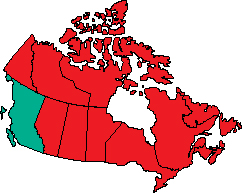
History
British Columbia was inhabited by the greatest number of distinct First Nations of any province or territory in Canada. Because of the diversity of the Pacific Coast — mild to cold climates, seashore to mountain tops — the nations that settled in this area developed completely different cultures and languages. They were different not only from each other, but also from the rest of the First Nations in Canada.
Among the First Nations along the coastline were the Nootka, Bella Coola, Tlingit, Haida, Tsimshian, Kwakiutl and Salish. The nations found on the plateaus of the Rocky Mountains included the Tagish, Tahltan, Tsetsaut, Carrier, Chilcotin Interior Salish, Nicola and Kootenay.
Unlike Eastern Canada, where the French and English disputed control of the land, the first two countries to contest areas of British Columbia were Spain and Russia. In the 1700s, the Spanish claimed ownership of the west coast of North America from Mexico to Vancouver Island. At the same time, the Russians were making an overlapping claim: control of the Pacific Coast from Alaska to San Francisco.
In 1778, Captain James Cook of Great Britain became the first person to actually chart the land. George Vancouver, a 20-year-old midshipman on Cook’s voyage, later led three expeditions of his own and charted more than 16,000 kilometres of coastline. Having firmly established her right to the area, Britain proceeded to settle disputes with both Spain and Russia.
The 1846 Oregon Treaty with the United States gave Britain sole ownership of Vancouver Island and the area north of the 49th parallel. In 1849, Vancouver Island was granted to the Hudson’s Bay Company in the hope that it might be settled. Until that time, the only European settlements in that part of the country were fur trading posts.
When gold was discovered in the lower Fraser Valley in 1857, thousands of people came in search of instant wealth. To help maintain law and order, the British government established the separate colony of British Columbia the following year. In 1866, when the frenzy of the gold rush was over, the colony of Vancouver Island joined the colony of British Columbia.
British Columbia was separated from the rest of British North America by thousands of kilometres and the imposing Rocky Mountains. The promise of a rail link from the Pacific Coast to the rest of Canada convinced the colony to join Confederation in 1871.

Coat of arms
The shield of British Columbia’s coat of arms was granted by King Edward VII in 1906. The complete coat of arms was granted by Queen Elizabeth II in 1987.
The Royal Union Flag, with an antique golden crown in the centre, occupies the upper third of the shield, symbolizing the province’s origin as a British colony. The bottom of the shield features a golden half-sun, superimposed upon three wavy blue bars cast horizontally on white. The blue bars represent the Pacific Ocean and the sun signifies British Columbia’s location as the most westerly province in Canada.
The shield, which was designed by Victoria clergyman Arthur John Beanlands, is supported by a wapiti stag and a bighorn sheep, representing the colonies of Vancouver Island and British Columbia.
The crest above the shield features a lion standing on a crown. The lion wears a garland of Pacific dogwoods and the provincial flower around its neck. Between the crest and shield is the golden helmet of sovereignty, a mark of British Columbia’s co-sovereign status in Confederation. Above the helmet are the traditional heraldic elements of a wreath and mantling in red and white, the colours of Canada. The provincial flower is featured a second time by entwining dogwoods around the motto scroll at the base of the arms.
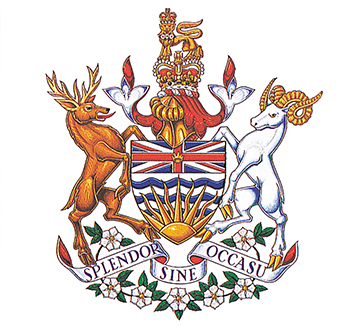
Motto
Splendor sine occasu (Splendour without diminishment)
Flag
The arms and banner for the British Columbia flag were assigned by royal warrant of King Edward VII in 1906, and the flag was adopted by Order of the Lieutenant Governor in Council in 1960.
With a design that duplicates the design of the provincial shield, the flag’s proportions are five by length and three by width.

Floral emblem
British Columbia’s floral emblem, the Pacific dogwood (Cornus nuttallii), was adopted in 1956. The Pacific dogwood is a tree that grows from 6 to 18 metres high and flowers profusely in April and May with large white blossoms. The tree is also conspicuous in autumn with its clusters of bright red berries and brilliant foliage.
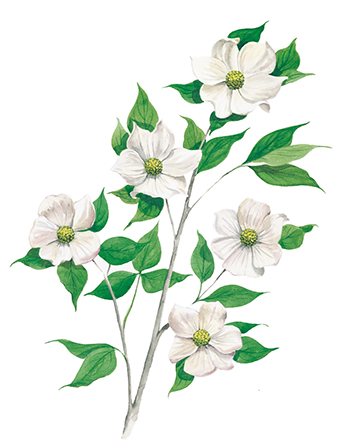
Other provincial symbols
Animal
The Kermode bear or “spirit bear” (Ursus americanus kermodei) was added to the list of British Columbia’s official symbols in 2006.
The greatest concentration of spirit bears can be found on the central coast and north coast of British Columbia. The spirit bear is not albino, but rather it is a black bear that has white fur due to a rare genetic trait.
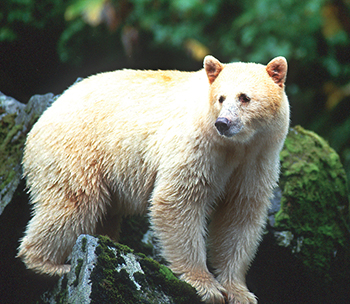
Bird
The Steller’s jay (Cyanacitta stelleri) can be found throughout British Columbia. It was adopted as the province’s official bird on December 17, 1987, based on the results of a province-wide vote.
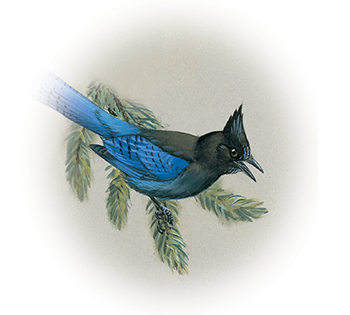
Mineral
Jade became British Columbia’s official mineral emblem in 1968.
Consisting mostly of nephrite, jade is prized by carvers of fine jewelry and sculptures at home, particularly in Asia. It is mined in many parts of British Columbia.
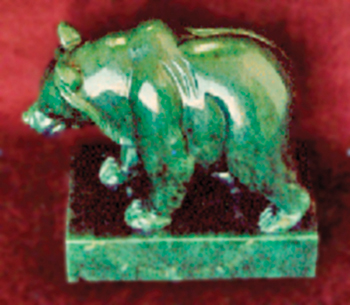
Tartan
The British Columbia tartan was designed by Earl K. Ward of Victoria and officially approved by the British Columbia Centennial Committee for the 1966-1967 Centenaries. Represented in the design are the blue of the Pacific Ocean; the green of the forests; the red of the maple leaf; the white of the dogwood floral emblem; and the gold of the crown and sun in the provincial arms.
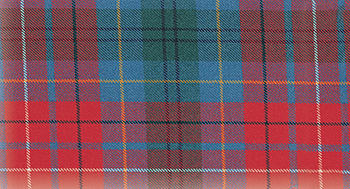
Tree
The western red cedar (Thuja plicata) was adopted as British Columbia’s official tree in 1988. The tree plays a key role in the traditions and lore of west coast native populations. It is also a major industrial resource for the province.
